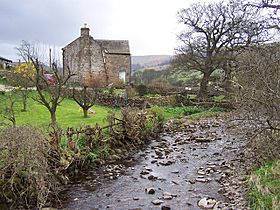Bishopdale Beck facts for kids
Quick facts for kids Bishopdale Beck |
|
|---|---|

Bishopdale Beck by Ribba Hall
|
|
|
Location of the mouth within North Yorkshire
|
|
| Country | England |
| Counties | North Yorkshire |
| District | Richmondshire |
| Physical characteristics | |
| Main source | Causeway Moss |
| River mouth | River Ure at Froddle Dub, Aysgarth 54°17′55″N 1°57′36″W / 54.2986°N 1.96°W |
| Length | 15 km (9.3 mi) |
Bishopdale Beck is an important stream, also known as a beck, in North Yorkshire, England. It flows through a beautiful area called Bishopdale. This valley is a smaller, side valley of the larger and well-known Wensleydale in the Yorkshire Dales national park.
Contents
About Bishopdale Beck
Bishopdale Beck is a key stream that eventually joins the River Ure. The River Ure is a much larger river in the region. The beck is about 9.3 miles (15 km) long from where it starts to where it meets the River Ure.
Where Bishopdale Beck Begins
The journey of Bishopdale Beck starts at a place called Causeway Moss. This is a flat area that connects Bishopdale to another valley called Wharfedale. As the beck flows, many smaller streams join it. These small streams come from the sides of the hills nearby. Some of these hills include Buckden Pike, Naughtberry, Wasset Fell, Stake Moss, Thoralby Common, and Stake Fell.
Joining the River Ure
The only big stream that flows into Bishopdale Beck is the River Walden, sometimes called Walden Beck. Finally, Bishopdale Beck meets the River Ure at a spot named Froddle Dub. This meeting point is about a mile east of the famous Aysgarth Falls.
Protecting the Beck
Organizations work hard to keep Bishopdale Beck healthy.
- The Yorkshire Dales Rivers Trust (YDRT) helps protect the natural environment of Bishopdale Beck. Their goal is to keep the beck in good condition from its source all the way to the Humber Estuary.
- The Ure Salmon Trust also helps look after the beck. They have done work to protect areas where salmon lay their eggs. For example, they have put up fences along the beck to stop farm animals from walking into the water. This helps keep the salmon's hatching areas safe. They have also put in special water troughs that use solar power for the animals to drink from. This means the animals don't need to go into the beck for water.


